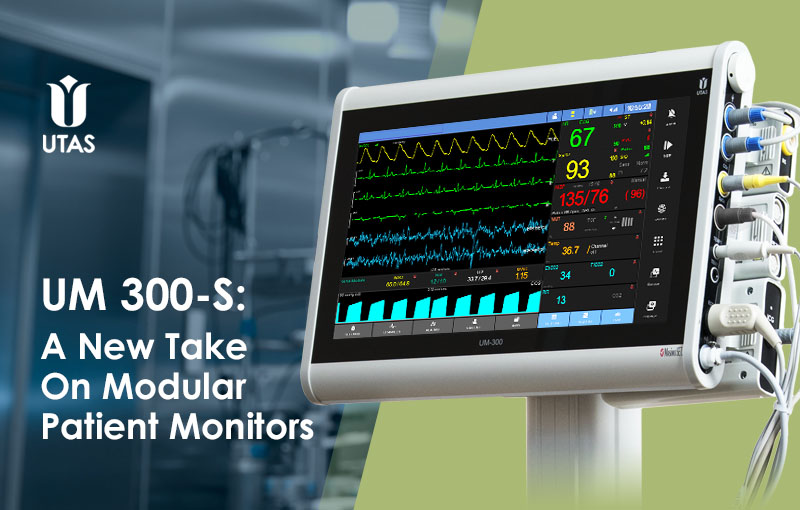
Hemodynamic Monitoring: Expanded Capabilities
in UM 300-S Patient Monitor
Reliable central hemodynamic monitoring is one of the key elements of modern intensive care. It is essential for making informed decisions in critical conditions and directly impacts patient safety. When advanced monitoring is needed, hemodynamic modules can be easily added to the UM 300-S patient monitors. Thanks to UniPort™ technology, these modules connect without unhandy consoles and without hidden licenses for optional soft. It allows clinicians to customize configuration tailored to anesthesia, cardiology, or intensive care requirements.
The extended hemodynamic monitoring set may include:
• IBP — Invasive blood pressure (up to 4 channels),
• C.O. — Cardiac output measurement by thermodilution,
• Noninvasive CCO (ICG) — Continuous cardiac output monitoring by impedance cardiography,
• Built-in hemodynamic calculator (in the base configuration),
• NIBP, ECG, HR, Resp, Temp and SpO2 are already in the basic set.
More about channels in basic and extended sets
Invasive Blood Pressure (IBP)
The monitor supports up to four independent IBP channels, with selectable measurement modes for each: ART, FEM, CVP, ICP, LA, RA, RV, LV, and others. Each channel can be individually configured for measurement mode, scale, alarm levels, color scheme, calibration interval, signal filtering, and more.
This flexibility is especially important in multi-parameter monitoring scenarios — for example, in operating rooms or intensive care units where pressure must be simultaneously tracked at multiple anatomical sites.
Noninvasive CCO by Impedance Cardiography (ICG)
Impedance cardiography is a modern method for continuous, noninvasive hemodynamic monitoring. It provides key parameters (direct and calculated) such as: CO (cardiac output), CI (cardiac index), SV (stroke volume), SI (stroke index), SVR/SVRI (vascular resistance), TFC (total fluid content), DO2I (Oxygen Delivery Index), and others.
ICG can serve as a reliable guide (especially for trend monitoring) in the treatment of mechanically ventilated patients [1], as they have a reduced ability to compensate circulating blood volume and face a significantly higher risk of fluid overload or hypoperfusion.
ICG offers an excellent balance of cost and functionality: catheter-free, minimal consumables, no delays — real-time data delivery. Moreover, its accuracy in many clinical scenarios is comparable to more expensive invasive technologies [1,2,3], making ICG a practical choice for everyday clinical practice.

Cardiac Output by Thermodilution: The Gold Standard
For situations requiring the highest accuracy and direct measurement, classical thermodilution is supported. This method is considered the «gold standard» in hemodynamics, especially for cardiac output monitoring in critically ill patients with pulmonary artery catheters. The integrated module provides convenient measurement initiation, automatic calculation, and result storage.
Hemodynamic Calculations and User-Friendly Interface
The built-in hemodynamic calculator in UM 300-S allows calculation of over 20 parameters, including cardiac index, stroke volume, systemic and pulmonary vascular resistance (SVR, PVR), ventricular work (LVSW, RVSW), and ejection fraction (EF) etc. Calculations are performed based on measured and entered data, without the need for unlocking additional paid options.
With UM 300-S, you can easily and quickly build the hemodynamic monitoring configuration you need. All data — at your fingertips, all capabilities — already in the monitor!
Read more about extended custom sets in UM 300-S Patient Monitor:
• For Anesthesiology • For Cardiology • For Neonatology
1. Sangkum, P. et al. Minimally invasive or noninvasive cardiac output measurement: an update. J Anesth 30, 461–478 (2016). https://doi.org/10.1007/s00540-016-2154-9
2. Yung, G.L. et al. Comparison of impedance cardiography to direct Fick and thermodilution cardiac output determination in pulmonary arterial hypertension. Congest. Heart Fail. 10, 7–10 (2004). https://doi.org/10.1111/j.1527-5299.2004.03406.x
3. Scherhag, A. et al. Comparison of impedance cardiography and thermodilution-derived measurements of stroke volume and cardiac output at rest and during exercise testing. Cardiovasc. Drugs Ther. 19, 141–147 (2005). https://doi.org/10.1007/s10557-005-1048-0



